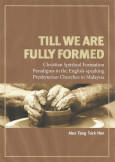Spiritual Formation to Shalom

Shalom is a Hebrew word, often translated in English as peace. In the Old Testament, shalom is a frequently used word. Greek scholar Mounce notes that LXX translates Hebrew šālôm, which occurs 250 times in the Old Testament with eirēnē (2006, 503). Examining the usage of the word in the Old Testament, Beck and Colin Brown discovered the usage of šālôm covers wholeness, completeness, well-being, prosperity, health, contentment and salvation. However it has a social dimension in good relationships between countries, righteousness and justice (Beck and Brown 1986, 777).
Theologian Hugh White uses a historical or developmental approach to understand the usage of the word šālôm in the Old Testament. He finds that šālôm are basically used in two settings. The first is its usage in a tribal setting in early Hebrew history where it denotes “an organic unity”, and secondly in a national setting as a covenant community (White 1973). In the tribal setting “the shalom of tribal life thus consisted of a dynamic, organically unified life process made stable by the institution of blood kinship” (White 1973, 9). The blood kinship was the static component but the dynamic life process involved living individually and corporately in such a way as to promote harmony and unity within the tribe. This concept was further expanded when the Hebrew became a covenant community. The promise of the covenant was “I will grant peace (shalom) in the land and you will lie down and no one will make you afraid.”(Lev.26:6a).
However as the tribal šālôm demands blood unity, the national šālôm demands obedience to the Yahweh covenant. Whites notes that “it is in this context, then, shalom acquires its connection with love, faithfulness, justice and righteousness” (1973,15). It is in the four prophets that White discovers the “eschatological prophetic visions of shalom” that links the Old Testament and the New Testament. These are Isaiah (prince of peace), Jeremiah (new covenant), Ezekiel (covenant of peace), and Deutero-Isaiah (suffering servant) (1973, 20-24).
In the New Testament, eirēnē is found 91 times, 24 of which are in the Gospels (Beck and Brown 1986,780). Beck and Brown comments that the meaning of eirēnē in the New Testament have the same “form and content” as its meaning in the Old Testament (1986,180). The expansion is that Christ himself is eirēnē (Eph.2:14-18), he is the mediator of eirēnē, bringing reconciliation (Col.1:20), and a “sense of wholeness both for men and the world (2 Cor.:17; Gal.6:15)” (Beck and Brown 1986,781). Beck and Brown notes “the whole process of believers’ sanctification, preservation and perfecting (1 Thess.5:23; Heb. 13:20) serves to deepen their participation in the peace of God” (1986,781). Christian spiritual formation may be understood as growing into shalom.
The Bible presents the time of the Garden of Eden before the fall as paradise. It would have been a time of shalom where there is what theologian Edward Powers describes as an ecology “of the relationship of people, creatures, and nature.” (Powers 1973,15). God is interested in a whole person, a whole people of his own, a whole earth and a whole creation which is implied in the concept of shalom. The Christian Story is about God recreating his shalom again. First, shalom is personal. It is a person finding wholeness by reconnecting to God and other people and learning to live without harming the environment. Theologian Norma Everist writes,
Shalom is about wholeness or completeness in an individual. Mounce notes that shalom is Jesus’ “parting gift”[1] to his disciples (2006,503). Joldersma, in unpacking Wolterstorff’s idea of shalom writes,
Therefore it is to shalom that the process of Christian spiritual formation of an individual proceeds.
Second, shalom is also for a community. Luke uses the word shalom to describe the early struggling Christian church (Acts 9:31). Expanding on this Everist writes,
The shalom concept of tribal and national or covenant community is now carried on by the laos or people of God (1 Peter 2:9-10). This means that a community must work together to create this shalom. Shalom is both something to work for and is also a gift from God (Rom.1:7; 1 Cor.1:3).
Finally, shalom is when the wholeness of all creation is restored with the creation of the new heavens and earth. This eschatological concept of shalom gives us hope and motivation in working to achieve it.
The concept of shalom gives an idea of what Christian spiritual formation should be achieving. Christian spiritual formation should be producing wholeness or completeness in individuals, communities and in the world. It also looks forward to an eschatological shalom. However shalom cannot be achieved without the restoration of the image of God in mankind. Christian spiritual formation is part of the process of the restoration of the image of God or imago dei which was perverted during the Fall (Demarest 1984,404). The complete restoration process or salvationstarts with justification by faith which is followed by Christian spiritual formation or sanctification and ends with glorification (Erickson 1999, 960-1013).
Bibliography
Beck, H. and C. Brown (1986). Peace. The New International Dictionary of New Testament Theology. C. Brown. Grand Rapids, MI, Zondervan. 2: 776-783.
Demarest, B. A. (1984). Fall of Man. Evangelical Dictionary of Theology. W. A. Elwell. Grand Rapids, MI, Baker Books: 403-405.
Erickson, M. J. (1999). ChristianTheology. Grand Rapids, MI, Baker Books.
Everist, N. C. (2002). The Church as Learning Community: A Comprehensive Guide to Christian Education. Nashville, Abingdon Press.
Mounce, W. D., Ed. (2006). Mounce's Complete Expository Dictionary of Old & New Testament Words. Grand Rapids, MI, Zondervan.
Powers, E. A. (1973). Signs of Shalom. Philadelphia, Joint Educational Development United Church Press.
White, H. C. (1973). Shalom in the Old Testament. Phildelphia, Division of Christian Education of the United Church Board for Homeland Ministries.
Wolterstorff, N. (2004). Educating for Shalom: Essays on Christian Higher Education. Grand Rapids, MI, William B. Eerdmans Publishing Co.
Endnotes
[1] Jn. 14:27; 16:33; 20:19, 21, 26
[2] Jer. 6:14; 8:11
Theologian Hugh White uses a historical or developmental approach to understand the usage of the word šālôm in the Old Testament. He finds that šālôm are basically used in two settings. The first is its usage in a tribal setting in early Hebrew history where it denotes “an organic unity”, and secondly in a national setting as a covenant community (White 1973). In the tribal setting “the shalom of tribal life thus consisted of a dynamic, organically unified life process made stable by the institution of blood kinship” (White 1973, 9). The blood kinship was the static component but the dynamic life process involved living individually and corporately in such a way as to promote harmony and unity within the tribe. This concept was further expanded when the Hebrew became a covenant community. The promise of the covenant was “I will grant peace (shalom) in the land and you will lie down and no one will make you afraid.”(Lev.26:6a).
However as the tribal šālôm demands blood unity, the national šālôm demands obedience to the Yahweh covenant. Whites notes that “it is in this context, then, shalom acquires its connection with love, faithfulness, justice and righteousness” (1973,15). It is in the four prophets that White discovers the “eschatological prophetic visions of shalom” that links the Old Testament and the New Testament. These are Isaiah (prince of peace), Jeremiah (new covenant), Ezekiel (covenant of peace), and Deutero-Isaiah (suffering servant) (1973, 20-24).
In the New Testament, eirēnē is found 91 times, 24 of which are in the Gospels (Beck and Brown 1986,780). Beck and Brown comments that the meaning of eirēnē in the New Testament have the same “form and content” as its meaning in the Old Testament (1986,180). The expansion is that Christ himself is eirēnē (Eph.2:14-18), he is the mediator of eirēnē, bringing reconciliation (Col.1:20), and a “sense of wholeness both for men and the world (2 Cor.:17; Gal.6:15)” (Beck and Brown 1986,781). Beck and Brown notes “the whole process of believers’ sanctification, preservation and perfecting (1 Thess.5:23; Heb. 13:20) serves to deepen their participation in the peace of God” (1986,781). Christian spiritual formation may be understood as growing into shalom.
The Bible presents the time of the Garden of Eden before the fall as paradise. It would have been a time of shalom where there is what theologian Edward Powers describes as an ecology “of the relationship of people, creatures, and nature.” (Powers 1973,15). God is interested in a whole person, a whole people of his own, a whole earth and a whole creation which is implied in the concept of shalom. The Christian Story is about God recreating his shalom again. First, shalom is personal. It is a person finding wholeness by reconnecting to God and other people and learning to live without harming the environment. Theologian Norma Everist writes,
Jesus made shalom through the cross (Col.1:20; Eph.2:15-16). When Jesus healed and forgave people, he dismissed them by saying, “Go in shalom.” We are to “seek and pursue it.”(Ps.34:14b as quoted in 1 Pet. 3:11 ). We are to be at peace, pursue it, send it, and keep it. Shalom is an active fruit of the spirit and a mark of the realm of God. It is about the matrix of peace, harmony, and wholeness and is both a gift and task for the very goal of our teaching and learning life together. Shalom is an active fruit of the spirit and a mark of the realm of God. It is about the matrix of peace, harmony, and wholeness and is both a gift and task for the very goal of our teaching and learning life together. (2002, 68-69)
Shalom is about wholeness or completeness in an individual. Mounce notes that shalom is Jesus’ “parting gift”[1] to his disciples (2006,503). Joldersma, in unpacking Wolterstorff’s idea of shalom writes,
Shalom means people living in right relationships with God, themselves, each other, and nature- and in taking delight in such relationships. Shalom involves finding meaning in our experiences and celebrating the actualizing of creation’s potentials. Shalom involves recognizing in ourselves that place where Gods’goodness finds its answer in our gratitude. Shalom is an ethical community where all the members have a full and secure place in the community. As such, it embraces a “non-abandonment” view of the creation that involves redeeming it.(Wolterstorff 2004, xii)
Therefore it is to shalom that the process of Christian spiritual formation of an individual proceeds.
Second, shalom is also for a community. Luke uses the word shalom to describe the early struggling Christian church (Acts 9:31). Expanding on this Everist writes,
Shalom is communal, meaning the right relationship between friends, neighbors, a community, nation, or even all the inhabited world (oikoumene). The heart of the meaning is close to life itself.
Shalom is linked with truth and justice in the Hebrew Bible, especially by Jeremiah[2]. Forgiveness, righteousness, justification, reconciliation, pardon, restoration, good news, and salvation - all words which point to harmony in any relationship- are all part of the semantic domain of shalom. In Paul’s theology in the New Testament Bible, justification by faith gives shalom with God through Jesus Christ.”(Everist 2002 ,68)
The shalom concept of tribal and national or covenant community is now carried on by the laos or people of God (1 Peter 2:9-10). This means that a community must work together to create this shalom. Shalom is both something to work for and is also a gift from God (Rom.1:7; 1 Cor.1:3).
Finally, shalom is when the wholeness of all creation is restored with the creation of the new heavens and earth. This eschatological concept of shalom gives us hope and motivation in working to achieve it.
The concept of shalom gives an idea of what Christian spiritual formation should be achieving. Christian spiritual formation should be producing wholeness or completeness in individuals, communities and in the world. It also looks forward to an eschatological shalom. However shalom cannot be achieved without the restoration of the image of God in mankind. Christian spiritual formation is part of the process of the restoration of the image of God or imago dei which was perverted during the Fall (Demarest 1984,404). The complete restoration process or salvationstarts with justification by faith which is followed by Christian spiritual formation or sanctification and ends with glorification (Erickson 1999, 960-1013).
Bibliography
Beck, H. and C. Brown (1986). Peace. The New International Dictionary of New Testament Theology. C. Brown. Grand Rapids, MI, Zondervan. 2: 776-783.
Demarest, B. A. (1984). Fall of Man. Evangelical Dictionary of Theology. W. A. Elwell. Grand Rapids, MI, Baker Books: 403-405.
Erickson, M. J. (1999). ChristianTheology. Grand Rapids, MI, Baker Books.
Everist, N. C. (2002). The Church as Learning Community: A Comprehensive Guide to Christian Education. Nashville, Abingdon Press.
Mounce, W. D., Ed. (2006). Mounce's Complete Expository Dictionary of Old & New Testament Words. Grand Rapids, MI, Zondervan.
Powers, E. A. (1973). Signs of Shalom. Philadelphia, Joint Educational Development United Church Press.
White, H. C. (1973). Shalom in the Old Testament. Phildelphia, Division of Christian Education of the United Church Board for Homeland Ministries.
Wolterstorff, N. (2004). Educating for Shalom: Essays on Christian Higher Education. Grand Rapids, MI, William B. Eerdmans Publishing Co.
Endnotes
[1] Jn. 14:27; 16:33; 20:19, 21, 26
[2] Jer. 6:14; 8:11
Labels: Descriptors Spiritual Formation, Spiritual Formation, Theology















0 Comments:
Post a Comment
<< Home